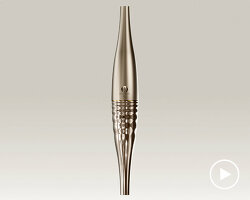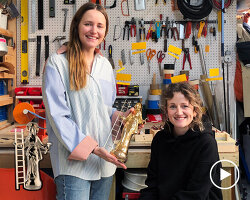
designboom interviews mathieu lehanneur who discusses working on each project as if it were his last
portrait © designboom
mathieu lehanneur is one of a handful of designers who seamlessly works across many creative fields, resulting in a portfolio of work that includes innovative objects and architecture that combine technology, science and art, ultimately delivering new experiences and products. designboom visited his studio located at the 2nd arrondissement in paris where we spoke with him regarding his take on design, the fine line between one-off pieces and art, his influences and current projects, including his ‘liquid marble’ installation and the ‘café mollien’ at the louvre museum.

a meeting table sits in the middle of the designer’s work area
image © designboom
designboom: what originally made you want to become a designer?
mathieu lehanneur: most of the time we read or hear designers saying that they started to draw and design when they were kids. frankly, at the beginning I was more focused on becoming a visual artist. so, I started to study art, but after five or six months I decided to stop, because it was quite open, quite inspirational in terms of feelings. in art, you are very free, very autonomous, and I was feeling that I was needing a kind of question, I was looking for a problem, for something to solve. I wanted a client to give me a question, to ask me to solve a problem. so, I changed my mind, and when I was around 20 I decided to apply to design school.
when I arrived there, I remember a big jury and they asked me ‘who is your favorite designer’, and I didn’t know even one. I was coming from art school and was not aware about design at all. so I said that I admired the designer / engineer who invented the escalator because it’s functional and beautiful, and I kept wondering how a mind could imagine a moving staircase. while I couldn’t give any name to the jury, my answer captivated them and they accepted me. I spent seven years in this school, it was quite long actually, and this was because I started to work, so I was spending my time on real problems, therefore my diploma kept on being postponed. since I was not absolutely focused on design history, existing design and existing products, this is probably one of the reasons my diploma project was ‘design of the medicine’. it was a type of weird thing, and it aimed to solve a problem called compliance that is the ability of the patients to understand the treatments and to follow them properly. today we know, and it’s a worldwide truth, that 50% of patients don’t take their medication properly: they stop before, they take it randomly, etc. what is sure is that it is not a problem of chemistry, which is what the pharmaceutical industry is only concentrated on this part. but they just started to understand that at the end there is a patient, and a patient is a human being. so they now know that they need to work with the patients, so it has to be solved by designers.
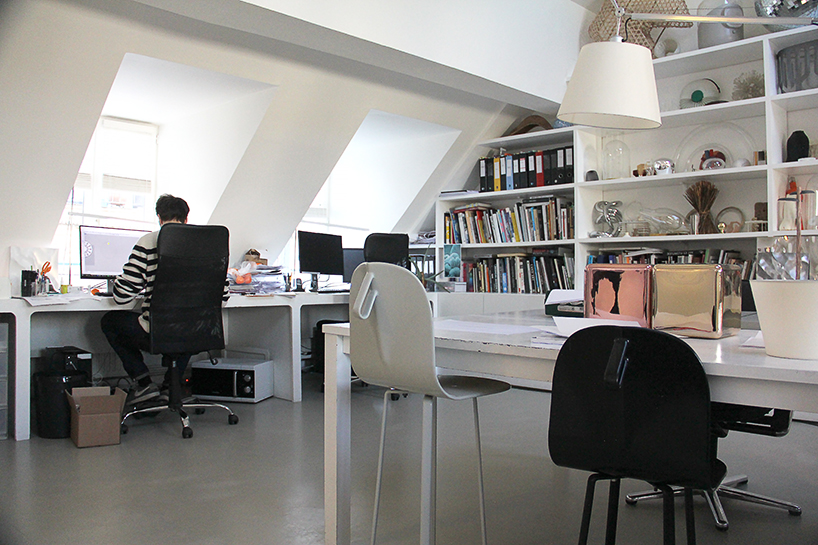
the team shares a luminous space where they can work together and share ideas
image © designboom
DB: so, where does the designer come in?
ML: the designer can do a lot of things because basically the raw materials used by the pharmaceutical industry is a white powder, like cocaine in a way. you can give it the shape you want, the texture you want, the sound you want when you eat it. it’s just like food, and food is not only food. food can be functional, it can give you pleasure, and it is fun. medicine can work in that sense. the idea was to work with different types of medicines that would help patients be involved, to clearly state the right posology (dosage) and duration of the treatment.

past projects, books and other references fill the studio’s shelves
image © designboom
DB: you are interested in working on pieces that go into galleries (limited editions, one-offs), but you are also involved in mass-production. both have different approaches. how do you view them?
ML: it’s quite different in terms of targets and in terms of process, but at the end of the day, the ways in which they are both created are not so different from each other. the chandelier for carpenters workshop gallery is a limited edition piece that is quite expensive because its process is complex. the piece was made using a type of industrial process because it involves a mix between ‘ready-to-wear’ – due to the standard elements that compose it (glass tubes) – but as soon as you decide to order one, we come and see the room where you want to install it, and according to the size and shape of the space, we will decide if it’s going to be a rectangular one, a high one, etc. so, this makes it a limited edition piece that is produced in an industrial way. I really want to avoid imposing strict boundaries between those two fields because you can really start to experiment in the limited edition world.
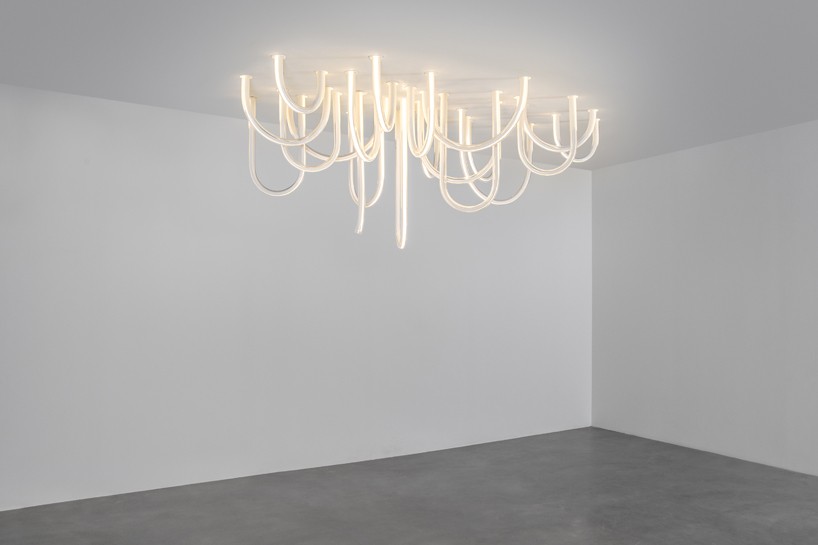
mathieu lehanneur’s ‘les cordes’ for carpenters workshop gallery
image courtesy of carpenters workshop gallery
see designboom’s coverage of the limited edition lighting project here
DB: what particular aspects of your background and upbringing have shaped your design principles and philosophies?
ML: I am the youngest of a family of seven children. I grew up in a micro-society in which the needs and desires of each one had to go after the group’s, the family needs. whatever the city or country in which we live, we all live in this situation of frequent confrontation between our own desires and the common interest. I probably became a designer to try to find solutions for the greatest number of people while attaching myself to understand and take care of each individual.
to pay my design studies I went ‘guinea pig’ for the pharmaceutical industry. I tested drugs before they went to market. I could be hospitalized for several days or weeks, I had time to think. I saw at that time drugs as a beautiful design subject, but also as a perfect metaphor of design that I would love to produce: a magical and therapeutic object. an object that does not reveal its function immediately and remains mysterious. finally, I saw an object that can be applied to the soul and spirit as much as it is for the body.

mathieu lehanneur’s private office
image © designboom
DB: who or what has been the biggest influence on your work to date?
ML: the moment I was saved by an airbag. in one hundredth of a second, the airbag became for me the best object ever designed. it is totally forgotten, invisible, it is made mostly of air, but it knows you before you need it, and it saves your life without asking anything in return.
DB: how would you describe your approach to design?
ML: better with it. you can live without it, but your life will be more beautiful with it!
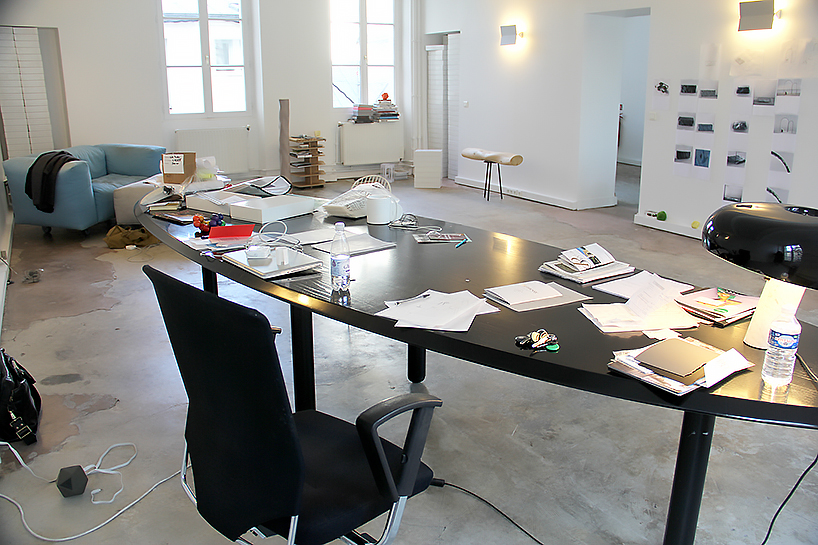
a view of the office from mathieu lehanneur’s perspective
image © designboom
DB: how has your role as a product designer evolved over the last 10 years? and how much of this has been a result of technological advancements?
ML: we all realized some years ago that a seventh continent made of waste plastics particles, as wide as a third of united states, floats in the pacific ocean. we also all realized — I hope — that designers play a major role in this sad discovery. as we strive to create desire, we create disappointment. an entire continent of disappointing particles … we must continue to create but I always keep in mind that each new production must be truly legitimate.

some of the designer’s past projects, including the ‘andrea’ air purifier, are showcased throughout his office
image © designboom
DB: what would you say is your studio’s strongest skill, and how have you honed it over time?
ML: we plan every project as if it were the first and the last. I encourage my studio’s designers to forget what we did previously. I don’t like design recipes, I cannot stand designers who copy themselves. each project is a new story, a new context and a new puzzle to solve. for that, I need every trace of the previous project to disappear. as soon as a project ends, I immediately request to remove drawings, mock-ups, and prototypes that remains in the studio. we create a new blank page, and we clean our mind to better stimulate again!

‘andrea’ and ‘power of love’ sit in a corner of lehanneur’s personal office
image © designboom
DB: in your opinion, what is the role of the designer?
ML: if you have nothing to say or bring that is interesting, it is better to remain silent.
DB: how, and to what extent, do other creative fields influence your design work?
ML: I never heard about a good definition of this profession. this is an unprecedented chance! design is a rare field that no one – not even the designers themselves – is truly able to explain. so, there is no defined borders and that leaves me the freedom to lead design to new territories.

bookshelves are adorned with models and prototypes of lehanneur’s projects like the ‘boom boom wireless speakers‘
image © designboom
DB: what are you currently interested in, and how is it feeding into your work?
ML: our brain is the lesser-known organ of our body, but we all know its importance. research on this subject has never been greater as it is today. it is a fascinating door of knowledge of the human being that is being opened. I am neither a scientist nor a neurologist, but it is a huge inspiration for a designer like me who is more interested in the human that the object!

the ‘café mollien’ designed by mathieu lehanneur situated at the louvre museum
image © michel giesbrecht
see designboom’s coverage of the project here
DB: could you tell us about what projects you are working on at the moment?
ML: we are working on the louvre café, where you continuously have to explain that you always need to respect the place, always respect everything of the existing building. so it’s kind of a paradox, the louvre and the city of paris; two places that always want to move forward, but also want to remain strictly historical, and exactly like it was. what is interesting in this project is the location because it’s located within a strategic point of the museum. on one side you have an amazing view including the exhibition rooms full of paintings and an amazing perspective; and on the other side you get the tuileries garden and the middle of that is the café. the interesting project is to find out the few elements that make this café interesting, and one of the main points of the project is that the ceiling is quite high. you cannot touch anything in the louvre, not the floors, walls or ceilings. there’s a big floor lamp just to feel the pressure of the void, three long elements made of brass that occupy this void that is quite visible from the exhibition rooms, three big balls of light can be seen, just to keep the perspective open. in terms of the chairs, we were on light and white elements.

‘liquid marble surface’ by mathieu lehanneur
images © michel giesbrecht
see designboom’s coverage of the project here
DB: what are you interested in working on next?
ML: I am currently working on a boat project. we’re working on a hybrid engine for a big, but quite light boat. it’s not a one off piece. the idea is to work, you know this type of inflatable boat that always has this kind of classical shape? to use the same kind of tubes, but totally change the way of building it, to avoid the same shape. this boat is about 16-17 meters, and it’s a day boat. there’s one cabin but it’s not for making long trips, and it’ uses a hybrid engine—basically to use what technology is already available to move it. what is interesting in this field is that boats encompass quite a traditional field, so its interesting to arrive to new ideas, and avoid being a specialist. I love not being a specialist of anything. I am a specialist of nothing. as soon as you become a specialist, you start to generate some mental recipes and your hands start to design by themselves. if you arrive like a kid in front of something new, you can ask stupid questions but this stupid question can in the end provide a smart answer.
so that being said, we are also preparing a new installation piece for a big vegetable garden festival in a castle in france. we are currently designing a kind of long pool made of marble, that will be a liquid vision of it. a few years ago my liquid marble installation we used a CNC process to create a realistic relief of marble of this liquid. this festival is very close to one of the most wild rivers in france. wild, because it hasn’t been too modified centuries after centuries, and the castle is just upon this beautiful river—the le loire. the idea is to put this this vision of the le loire river in the garden so even though you are far away from the river, you will be able to walk on it.

‘petite loire’ highlights the ways in which marble, water and light come together to evoke a dynamic feeling of a river
image © michel giesbrecht
DB: is there a designer and/or architect from the past you appreciate a lot? and those still working / contemporary?
ML: I am a great admirer of r. buckminster fuller. I like the liveliness and plasticity of his mind. I love its ability to be both scientist and designer, architect and philosopher, mathematician and teacher… he visualizes the problem or need, and creates competence to solve it.
I admire elon musk for the same reasons. such people do not create from their own competences, they create their skills to achieve what they seek.

mathieu lehanneur’s studio is located in the 2nd arrondissement in paris
image © designboom
DB: how would you say the role of media is impacting the field of design?
ML: media is like girls, the best way to attract them is to make them believe that we are not so interested in them…
DB: what is the best advice you have ever received, and what advice would you pass on to young designers?
ML: don’t go get inspiration from others designers. inspiration is like food: to be rich and nutritious it must be raw, intact, whole. what you see from other designers is food that has been already eaten and digested… go look elsewhere, walk and go find fruits that have not yet fallen from the tree.

the private office of mathieu lehanneur is minimlistic
image © designboom
DB: what is your motto?
ML: end my life by telling myself that I could not do more and I could not do better. end my life tired but glad and delighted to have lived so well.

‘strates’ desk by mathieu lehanneur for objekten
image © designboom
see designboom’s coverage of the project here







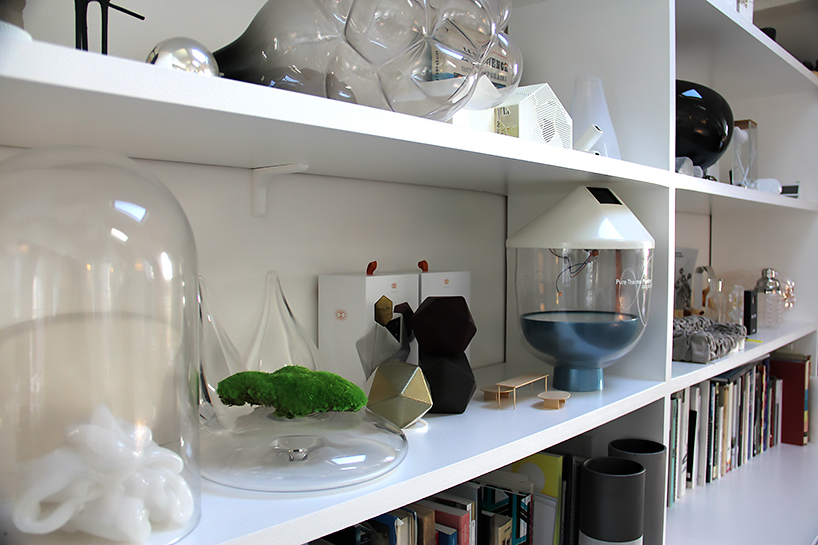
Save
Save
Save
Save
Save
Save
Save
MATHIEU LEHANNEUR (43)
STUDIO VISITS (108)
PRODUCT LIBRARY
a diverse digital database that acts as a valuable guide in gaining insight and information about a product directly from the manufacturer, and serves as a rich reference point in developing a project or scheme.

